This Earth Day, celebrate the little things
By EMMA KUKUK and RACHEL COALE
Michigan Department of Natural Resources
Envision standing under a forest canopy of countless leaves, hiking through a field spangled with native wildflowers, digging your toes into the sand of a Great Lakes beach or watching colorful warblers as they flit through your backyard.
Take in that moment.
Michigan’s outdoor wonders are a reminder that each of us is a small part of a stunning, complex natural world – a world that is connected.
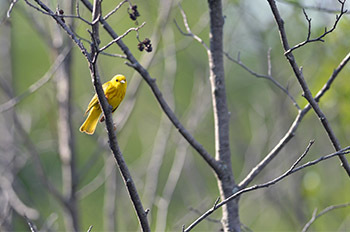
Although we often think of ourselves as going “into” and “away from” nature, there’s a fundamental shift in perspective when we consider the fact that we are nature. We can shape the world around us, and we carry a responsibility to consider our impact on our beautiful and important landscapes.
Earth Day is today, April 22, which each year commemorates the anniversary of the modern environmental movement’s birth in 1970.
As we celebrate our planet, remember that we are an important part of our world — and we can all help keep it safe, healthy and clean for everyone.
Conserving the environment one step at a time
For the past 100 years, the Michigan Department of Natural Resources has stewarded the conservation of our state’s natural resources and protected the environment with its sister agency, the Michigan Department of Environment, Great Lakes and Energy.
Today, dedicated staffers continue to find ways to restore native species, produce clean energy, manage forests to lock up carbon and take bold steps to prevent the introduction of invasive carp to the Great Lakes.
|
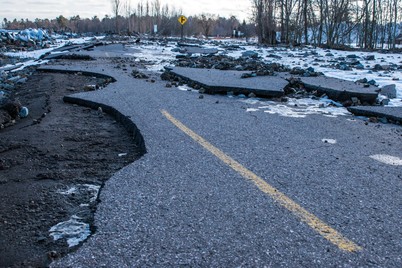
Progress is also afoot on a local scale. Staff is partnering with communities to help stop the advance of invasive species, plan virtual 5K races to plant trees and update facilities to save funds and fuel.
See what the DNR has been up to for the past 100 years at Michigan.gov/DNRCentennial.
While much has been accomplished over the more than half-century since the first Earth Day, Michigan, the U.S. and the world have many significant environmental challenges remaining.
Climate change and the Great Lakes
The Great Lakes are the largest freshwater system in the world and hold more than 20% of the Earth’s fresh water supply. They account for more than 90% of surface fresh water in the United States and provide important shipping routes and tourist attractions. The Great Lakes are also a key part of Michigan’s cultural identity.
Between 1999 and 2014, the lakes experienced the longest period of low water levels in recorded history — to the point that some worried about the lakes disappearing. But since 2014, the Great Lakes have been experiencing record high water levels.
|

Scientists are in agreement that these swings between high and low water levels are being driven by climate change.
Erosion from high water has affected shorelines, roads, beaches, rivers and more. Stronger currents make swimming in the lakes more dangerous and threaten important fish habitat. Changes to our beloved lakes require serious consideration.
As human activity continues to affect our planet, it’s important for individuals, agencies, businesses and other entities to consider their own impacts on the environment.
An estimated 10,000 metric tons of plastic enter the Great Lakes every year. That’s 22 million pounds. While at first glance it may seem like the waters are clear and the beach sand is free of debris, there is much more than meets the eye.
Sometimes the smallest things are the most damaging.
Nearly 40 million people rely on the Great Lakes for drinking water. Microplastics that are too small to be filtered through water treatment facilities end up washing out to the lakes and into the drinking water supply. These microplastics are also mistaken as food by animal species, which can contribute to early death of the animal or introduction of plastics into our own food.
Things in our everyday life contribute to climate change and disruption.
|

Washing synthetic clothing is the largest source of microplastics in aquatic environments and watersheds. Illegal dumping of garbage contaminates the environment and vehicle exhaust has increased air pollution and can affect human health.
Swapping synthetic materials for natural fibers, cleaning up dump sites and choosing more eco-friendly travel alternatives when available are just some ways we can combat climate change. Encouraging agencies and businesses to commit to sustainability is also important.
Reducing plastic use and choosing reusable products — like metal water bottles and straws — or compostable materials over plastics may seem like tiny actions to take.
Sometimes, small changes can also make real impact when implemented at scale.
Advances on energy and carbon
“In our buildings, we’re replacing inefficient heating systems, switching to LED lighting and adding insulation for energy savings,” said Sharon Conley, facilities and equipment coordinator for the DNR’s Forest Resources Division.
The DNR is also using mass timber — an emerging, sustainable construction material — for its new DNR customer service center and field offices in Newberry.
In addition to these efforts, the DNR is initiating pilot projects to generate carbon offset credits from state forest lands and establishing large-scale solar arrays on former mineral development sites unsuitable for other uses.
|

These projects are intended to help Michigan along the path to economic carbon neutrality, repurpose underutilized public lands for greater benefit and mitigate the impacts of climate change.
The DNR is also instituting sustainable systems in its fisheries management efforts.
In 2020, the DNR awarded a contract for solar power development at the Oden State Fish Hatchery in Emmet County to reduce energy costs and greenhouse gas emissions. The department is making a concerted effort to convert facilities to renewable energy sources and taking steps toward sustainability.
It’s vital that humans become better stewards of the earth. A big part of that is recognizing where people can make real, lasting change.
Threats beneath the surface
An awareness of environmental issues like legacy pollution is growing and reinforcing the need to care for our resources. These “invisible” contaminants, like mercury, PCBs and PFAS, are more difficult to deal with than more obvious pollution like trash and have negative effects on fish, wildlife and human health.
Much of the work to combat environmental threats happens through remediation and cleanup programs administered by the Michigan Department of Environment, Great Lakes and Energy.
One initiative, the Areas of Concern Program, is an example of how progress can be made but often happens at a pace that can span a career.
Michigan started with 14 contaminated Areas of Concern in the 1980s, designated by the U.S. Environmental Protection Agency, under the binational Great Lakes Water Quality Agreement.
|
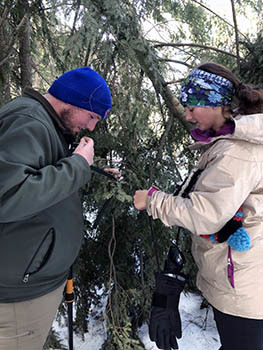
Through community partnership and Great Lakes Restoration Initiative funding, these parts of the Great Lakes system with human-caused environmental problems have seen forward progress, and three sites are now fully restored.
Invasive species
Stopping contamination before it starts, or keeping an invasive species out before it spreads, is much easier than cleaning up the damage after it’s happened.
One major project to combat threats to the Great Lakes saw a big step forward this year. The invasive carp prevention project at the Brandon Road Lock and Dam in Illinois is an ambitious effort with plans to use layered technologies to prevent the movement of invasive carp.
The project, a combined effort between the State of Michigan, the State of Illinois and the U.S. Army Corps of Engineers is designed to keep invasive carp out of the Great Lakes.
Invasive carp are prevalent in the Mississippi River, which connects to Lake Michigan via the Chicago Area Waterway System. The introduction of bighead, silver or black carp to any of the Great Lakes would be disastrous. Having no native predators and voracious appetites, invasive carp would push out native species like lake whitefish, walleye, lake trout and muskellunge, dramatically affecting the lakes’ ecosystems and disrupting major food sources for many people who depend on fish from the lakes.
The presence of these species would also have a drastic effect on the region’s $7 billion fishery, $16 billion boating industry and other tourism-based industries, property owners, recreationists and others who rely on the Great Lakes and their tributaries.
An awareness of these threats we may not immediately see is just as important as keeping an eye out for obvious threats to our environment.
Community involvement
Community science, the collection of data and observations by community members, is providing important information to help manage and protect natural resources.
|
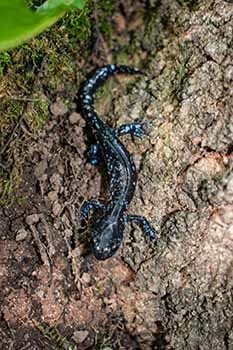
Digital platforms like eBird and iNaturalist make sharing data as easy as uploading a selfie to Instagram. This real-time information helps researchers and natural resource managers learn more about wildlife behavior and the impacts of development and climate change.
From monitoring osprey nests and counting the songs of rare birds to reporting sighting of amphibians and reptiles, community members help keep track of these species’ populations and abundance. This data is a critical part of the DNR’s Wildlife Action Plan and helps wildlife biologists create management plans for various species.
Community science is especially valuable in the effort to prevent and protect against invasive species. Community reports of the tiny, tree-killing hemlock woolly adelgid, for example, allow forest health staffers to inoculate hemlock trees to prevent tree loss.
A call about the barbed, invasive “mile-a-minute weed,” named for its incredibly fast growth and potential to overwhelm native plants, enabled conservation groups to find it and begin management actions to prevent further spread.
|

Early detection and response to invasive species is key – finding infestations early means there is a much better chance of containing and controlling them.
“Without the public’s assistance and participation, we would not be where we are,” said Joanne Foreman, DNR invasive species communication coordinator. “We can’t see everything — that’s the bottom line. We’re reliant on community support.”
As threats like the spotted lanternfly and beech leaf disease creep closer to Michigan, informed and watchful community members are the first line of defense when it comes to fighting invasive species.
Learn about invasives with NotMISpecies webinars from Michigan’s Invasive Species Program and report sightings out in the wild.
“The best way to help fight invasive species while you’re enjoying the outdoors is to make Clean, Drain, Dry and Play, Clean, Go part of your recreation habits,” Foreman said. “Make sure your gear and equipment are clean before you leave so you don’t bring an invasive species to a place you love. Even small changes to your recreation routine can have a big impact on outdoor spaces.”
Take an active role in caring for the places you’re passionate about by lending a hand on a DNR stewardship workday or organizing a local Adopt-a-Forest cleanup. These programs make an incredible difference in the health and beauty of outdoor spaces.
More ways to get involved, like providing public input on natural resources plans and reporting invasive species, are available on the DNR’s Get Involved webpage.
The road to recovery
For many, it’s hard to imagine a time when white-tailed deer weren’t prevalent in southern Michigan, or when wild turkey and giant Canada geese were rare — when the waters were so polluted that the Rouge River caught fire and Lake Erie’s beaches were closed to swimming.
|
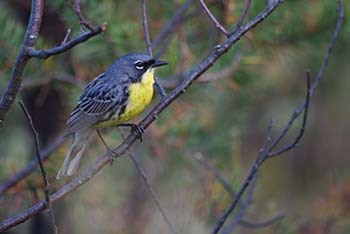
Al Stewart, who just retired after a 50-year career with the DNR, doesn’t have to imagine. He was there.
“In the 70s and on, there were many animals of scarcity. The Kirtland’s warbler was almost extinct. Elk were declining due to poaching,” Stewart said. “Osprey in Michigan were just satellite populations, they never really blossomed.”
Stewart wrote the original southern Michigan osprey restoration plan, which has come to fruition. He also played a prominent role in the state wild turkey reintroduction efforts.
This is just one of the many success stories. Other notable comebacks are wild turkeys and elk, which were both extinct locally before being reintroduced to the state by DNR wildlife biologists.
A cheery “chip-chip-chip-che-way-o” whistling through northern lower Michigan’s jack pine forests is more than just birdsong – it’s a happy victory call for a coalition of partners who helped save the only nesting place on the planet for the Kirtland’s warbler.
Thanks to their dedication, birders from across the globe can still find the tiny, yellow-and-gray bird in its natural Michigan habitat. Added to the federal endangered species list in 1967 and removed in 2019 after decades of forest management and habitat restoration, the Kirtland’s warbler is living proof that species can be saved from the brink of extinction.
A major factor in the comeback of endangered species like the giant Canada goose was individuals and communities taking an active interest in their return.
The return of these animals has been heralded as a great success, and it’s something that can be built on as we turn to recovering other species.
Pollinators
Across the country, many species still face threats. Native pollinator populations are plummeting due to habitat loss, pesticide use, disease and climate change. Our ecosystems rely on diversity of these pollinators, which are keystone species for food security and healthy environments.
|
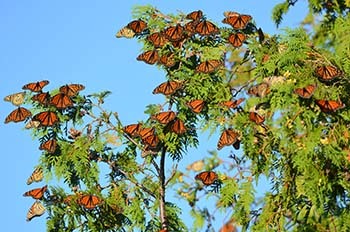
Managed honeybee hives pollinate one third of the food we consume daily. Of the 300-plus crops grown in Michigan, about 100 are pollinated by bees. Native bee species are two to three times more effective at pollination than honeybees, but they face greater threats.
Wasps and other insects are also valuable pollinators, as well as important predators of pest insects. Each has a critical role on their local ecosystems, and it’s important to recognize when they need help.
One way to lend a hand is to plant a pollinator garden in your yard or add native plants and trees to your landscaping. You can even get certified as an official Monarch Waystation if you plant milkweed.
In particular, the U.S. Fish and Wildlife Service has acknowledged that the iconic monarch butterfly now meets endangered species criteria, although it is still in the process of being officially listed.
The monarch and other, lesser-known plants and animals, like many salamanders, insects and Great Lakes mussels, are also in peril. The Michigan Natural Features Inventory maintains lists of plant and animal species of concern.
We may not always see these species, but they all have an important role to play in our world. They may seem small – or even sometimes a nuisance – but they’re a vital part of the ecosystems we rely on for our food, our industries and the health of our environment.
“The changes in the past were focused on wildlife species, the changes of today are focused helping people understand the work we do for the benefit of all people and our natural resources,” Stewart said. “If you have an interest in a species that needs your help, get involved. One person can do anything.”
Making the outdoors welcoming to all this earth day
Michigan’s public lands and facilities are available for all people to explore, no matter your experience, your background or your ability.
|
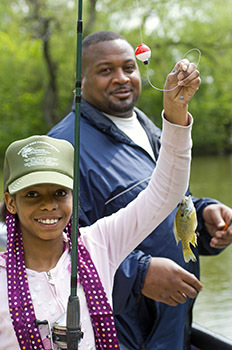
When the COVID-19 pandemic first hit, the outdoors became a safe place to get outside while maintaining social distance. Many people experienced Michigan state parks fishing, hunting and other recreation for the first time.
Hunting and fishing license sales skyrocketed during 2020, and so did attendance at all 103 state parks. With many newcomers to these areas, it’s important to recreate responsibly, be courteous to others and ensure everyone has the chance to enjoy these places and activities to their fullest.
You can find areas to enjoy the outdoors near you and check for closures on the DNR website. Remember to leave no trace. Public lands and properties are open to everyone, whether you’re an outdoor recreation veteran or just stepping on the trail for the first time.
Report poaching or dumping trash in the forest by calling the DNR Report All Poaching line at 1-800-292-7800 and let us know.
The best thing you can do to protect the outdoors and make outdoor spaces welcoming to all is to inspire a passion for nature in someone else. Take a child fishing, introduce a friend to hiking or share your experiences and skills a with another person.
The earth is for everyone
All species, not just humans, rely on delicately balanced ecosystems. With human-driven impacts, many of those systems have been thrown out of equilibrium. The choices we make in our everyday lives can help bring us closer to restoring that important balance.
People who care about nature and the outdoors often act in ways that reflect that passion. They pick up trash when they go for hikes, bring reusable bags to the grocery store or have a backyard compost pile turning scraps into rich soil. They take an active interest in the world around them. They help people new to the outdoors understand how to enjoy it properly and safely.
Though sometimes it may not feel like each of us can make a difference, even small changes can have a huge impact. We’re all a part of the wonderful natural world, and it’s our job to take care of it.
This Earth Day, be an advocate for our natural spaces and species and help inspire action in your community.
|
Check out previous Showcasing the DNR stories in our archive at Michigan.gov/DNRStories. To subscribe to upcoming Showcasing articles, sign up for free email delivery at Michigan.gov/DNR.
/Note to editors: Contact: John Pepin, Showcasing the DNR series editor, 906-226-1352. Accompanying photos and a text-only version of this story are available below for download. Caption information follows. Credit Michigan Department of Natural Resources, unless otherwise noted.
Text-only Showcasing Story - Earth Day
Adelgid: Cooperative invasive species management area surveyors check for hemlock wooly adelgid in Michigan.
Damage: Significant high-water damage caused to Lakeshore Boulevard in Marquette after fall storms. The road was rerouted away from Lake Superior at substantial cost.
Debris: Brightly colored sorted plastic trash items picked up in a beach clean-up.
Lincoln: Maple leaves brighten an afternoon at Lincoln Brick Park in Eaton County.
Ludington: A well-traveled footpath over the sand dunes at Ludington is shown.
Monarch: Monarch butterflies on their southward fall migration are shown gathered at Peninsula Point in Delta County.
Mustard: An interpretive sign tells visitors to the Forest Lake State Forest Campground in Alger County how to help stop the spread of invasive garlic mustard.
Palmer: A young girl learns to fish for panfish at Palmer Park in Detroit.
Pigeon: Autumn is about to fall on the Pickerel Lake State Forest Campground in the Pigeon River Country of northern Lower Michigan.
Salamander: A blue-spotted salamander is shown. The city of Marquette temporarily blocked off a road to allow the salamanders to migrate to breeding areas for spring.
Sunrise: Dawn breaks over Deer Lake in Marquette County.
Timber: Mass timber, a new development in building materials, is shown. (Michigan State University photo)
Warbler: A male Kirtland’s warbler, one of the conservation successes in Michigan’s efforts to improve habitat for threatened and endangered species, is shown.
Yellow: A male yellow warbler is photographed in a wetland in Marquette County, where it was setting up a nesting territory in spring./
|